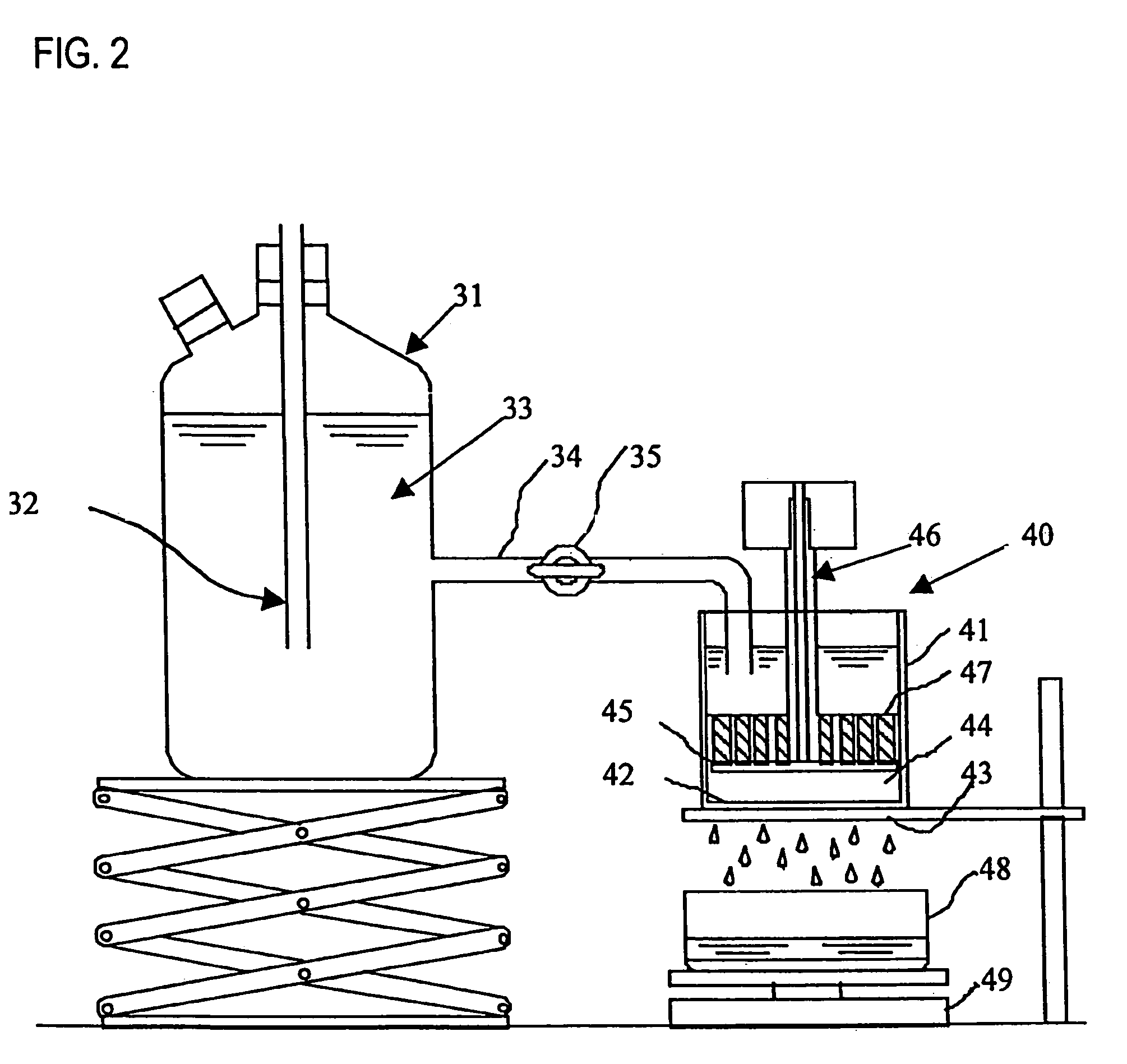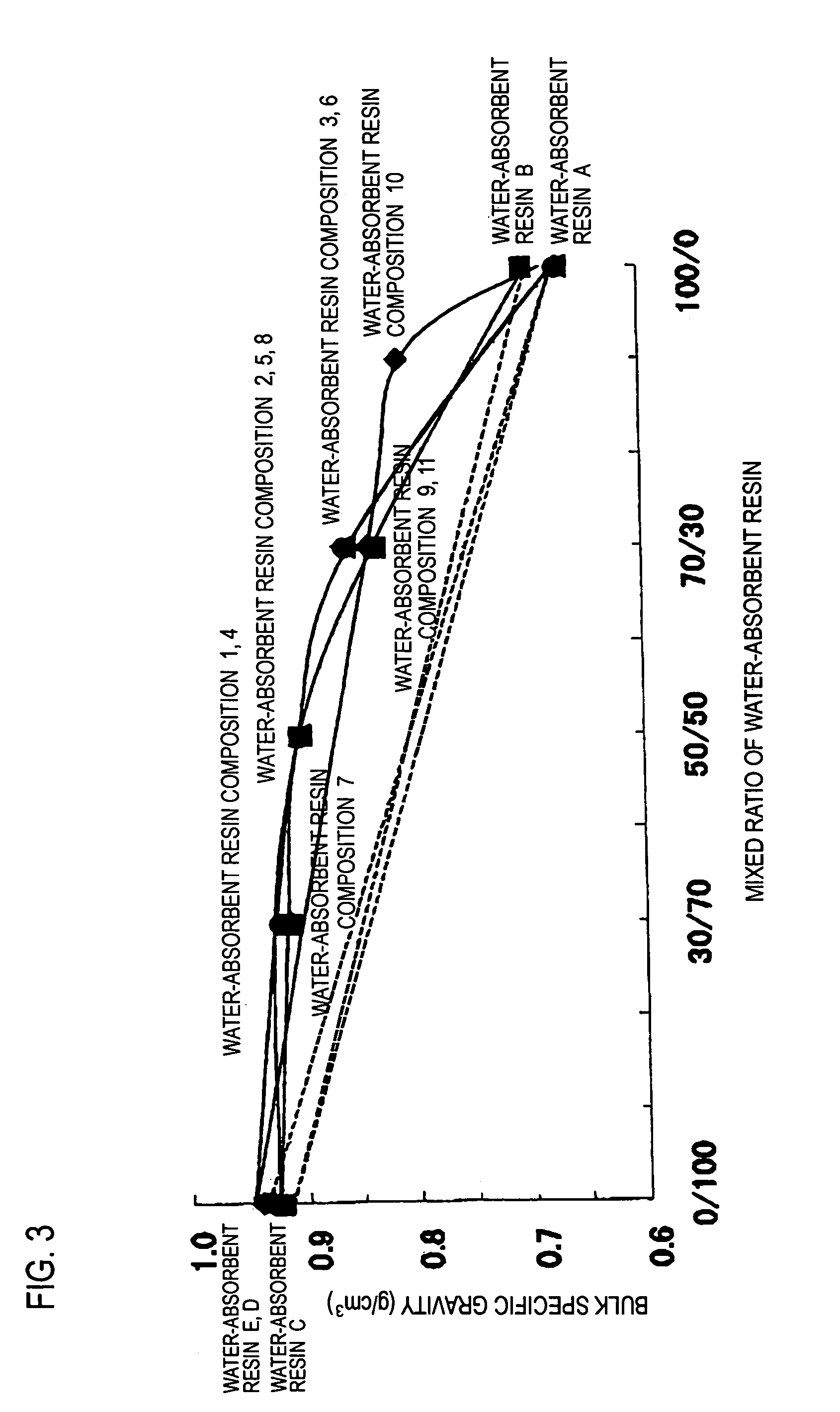Water-absorbent resin composition
a technology of resin composition and water absorption, which is applied in the direction of bandages, coatings, other chemical processes, etc., can solve the problems of lowering the speed of water absorption, affecting the absorption efficiency of water, so as to achieve good absorption performance, improve absorption capacity, and reduce wall thickness
- Summary
- Abstract
- Description
- Claims
- Application Information
AI Technical Summary
Benefits of technology
Problems solved by technology
Method used
Image
Examples
referential example 1
Method for Production of Water-Absorbent Resin A
[0151]A reaction solution was obtained by dissolving 8.1 parts of polyethylene glycol diacrylate (n=8) in 5500 parts of an aqueous 38 wt. % sodium acrylate solution (ratio of neutralization 71 mol %). Then, this reaction solution was deaerated in an atmosphere of nitrogen gas for 30 minutes. Then, the reaction solution mentioned above was supplied to a twin arm type kneader made of stainless steel, fitted with a closable lid, and provided with two sigma type vanes. The system was displaced with nitrogen gas with the solution kept at 30° C. Subsequently, the reaction solution was kept stirred and 2.4 parts of ammonium persulfate and 0.12 part of L-ascorbic acid were added to the stirred reaction solution. After the elapse of about one minute thence the reaction solution began polymerizing. Then, the polymerization was carried out at 20–95° C. of peak temperature. After the elapse of 60 minutes following the start of polymerization, a po...
referential example 2
Method for Production of Water-Absorbent Resin B
[0154]A reaction solution was obtained by dissolving 8.3 parts of polyethylene glycol diacrylate (n=8) in 5500 parts of an aqueous 33 wt. % sodium acrylate (ratio of neutralization 75 mol %) solution. Then, this reaction solution was deaerated in an atmosphere of nitrogen gas for 30 minutes. Subsequently, the reaction solution mentioned above was supplied to a twin arm type kneader made of stainless steel, fitted with a closable lid, and provided with two sigma type vanes. The reaction solution was kept at 30° C. and the system was displaced with nitrogen gas. Then, the reaction solution was kept stirred and 2.4 parts of ammonium persulfate and 0.12 part of L-ascorbic acid were added to the stirred reaction solution. After the elapse of about one minute thence, the reaction solution began polymerizing. Then, the polymerization was carried out at 30–90° C. After the elapse of 60 minutes following the start of polymerization, a polymer i...
referential example 3
Method for Production of Water-Absorbent Resin C
[0157]An aqueous monomer solution having a monomer concentration of 35 wt. % and a ratio of neutralization of 75 mol % was obtained by using 21.6 parts of acrylic acid, 228.6 parts of an aqueous 37 wt. % sodium acrylate solution, 0.0185 part of N,N′-methylene bisacrylamide (0.01 mol % based on the monomer), 0.106 part of hydroxyethyl cellulose, and 53 parts of deionized water. The dissolved oxygen in the aqueous monomer solution was expelled by having 0.09 part of potassium persulfate dissolved therein and blowing nitrogen gas therein.
[0158]In a four-neck separable flask fitted with a stirrer, a reflux condenser, a thermometer, a nitrogen gas inlet tube, and a dropping funnel, 800 parts of cyclohexane was placed, 4 parts of sucrose fatty acid ester (HLB=6) as a dispersant was dissolved therein, and nitrogen gas was blown in to expel the dissolved oxygen. Then, the aqueous monomer solution was added while in a stirred state into the sep...
PUM
| Property | Measurement | Unit |
|---|---|---|
| pressure | aaaaa | aaaaa |
| mol % | aaaaa | aaaaa |
| weight average particle size | aaaaa | aaaaa |
Abstract
Description
Claims
Application Information
 Login to View More
Login to View More - R&D
- Intellectual Property
- Life Sciences
- Materials
- Tech Scout
- Unparalleled Data Quality
- Higher Quality Content
- 60% Fewer Hallucinations
Browse by: Latest US Patents, China's latest patents, Technical Efficacy Thesaurus, Application Domain, Technology Topic, Popular Technical Reports.
© 2025 PatSnap. All rights reserved.Legal|Privacy policy|Modern Slavery Act Transparency Statement|Sitemap|About US| Contact US: help@patsnap.com



